The History of the Bible
 --Lecture
Notes for Topic 3.0-
--Lecture
Notes for Topic 3.0-
Establishing
a Christian Bible: 100 AD to the Protestant Reformation
Last revised: 10/01/06
Explanation:
Contained below
is a manuscript summarizing the class lecture(s) covering the above specified
range of topics covered in the study. To display any Hebrew or Greek
text contained in this page download and install the free BSTHebrew and
BSTGreek
from Bible Study Tools.
Created
by  a division of
a division of  All rights reserved©
All rights reserved©
|
|
|
What do we need
to learn this week?
After examining how both testaments
of the Christian Bible came into being, we need now to take a look
at how they came together as a Bible comprised of the Old Testament and
the New Testament. That history should give attention first to how
copies of sacred documents were made. This will be foundational to
these documents being distributed and thus sought to gain credibility in
the eyes of various ancient Christian communities. The result of this copying
process was to produce thousands of manuscripts that were distributed either
as individual documents or mostly as a collection of documents. The hand
copying process had numerous weaknesses built into it. The result was to
produce manuscripts that contained large numbers of variations in wording
in the texts.
The immediate question that comes is
"Where does the content of our English Bible come
from?" Since the beginning of the modern era of the printing press,
those who print a Greek New Testament and a Hebrew Old Testament are forced
by necessity to make decisions about the exact wording of a biblical language
text. How are such decisions made? On
what basis, since the copied manuscripts differ so much in their wording?
The answer to these questions lies in a brief overview of a technical process
of analyzing the now existing manuscripts of the biblical texts. The goal
is to seek the most accurate wording possible. The standard for measuring
accuracy is the exact wording of each document when it was first written.
But why not just go back to the original documents
themselves? Unfortunately, these documents no longer exist. And
further complicating the process is that for the New Testament, existing
manuscripts, that cover the full content of the New Testament, reach back
no earlier than three hundred years after the original writing of each
document. The situation is more challenging for the Hebrew test of the
Old Testament. This process of analysis of available manuscripts is a highly
technical discipline called
Textual Criticism. We will
take a quick look at it, both in its New Testament application, and also
in its very different Old Testament application.
Finally, we will give consideration
to the central role that the Latin Vulgate has played
in Christian history. By the fifth century it had become the
Bible for western Christianity. And it remained so for all Christians in
the west until the Protestant Reformation. For Roman Catholics it still
remains the Bible. Additionally, it has impacted the English Bible in many,
many ways from the very beginning, and remains an influence on the English
Bible used by most Protestants today. Modern English Roman Catholic translations
must pay close attention to the Vulgate, if these are to gain the approval
of the Vatican.
3.1
Copying
the Bible: How were copies of the Bible
made before the printing press?
In the ancient
world, no typewriters or computers existed. So
how did people put their ideas in written expression?
The answer: very laboriously, using very primitive writing tools. This
tended to push writing toward the experts who were especially trained for
this. By the beginning of the Christian era, most writing outside of very
short personal letters -- less than one page -- was done by professional
scribes.
3.1.1
How did people write in the ancient world?
In the world at the beginning of the
Christian era a variety of writing materials were used. Each tended to
have specific purposes and situations. The graphics below illustrate the
variety of materials and instruments used in writing.
Of the five types of writing materials
illustrated above, the wax tablet was the main writing material for school
boys, although it was used for other things. A fine layer of wax was spread
over a flat piece of wood. The wax could be heated to erase the writing
that had been placed on it using a stylus while the wax was warm. Ostraca
was pottery with inscriptions etc. on it. Most of what we have available
today are broken pieces of pottery. "Paper" was not produced until after
the 8th century AD, and does not figure in prominently with the copying
of the Bible until the middle ages. Papyrus was the most common writing
material in the ancient world, and was widely used. Parchment -- Vellum
-- was tanned leather and was widely used in copying the Bible from the
fourth through the fourteenth centuries. The writing instruments ranged
from hollowed out reeds to bone or wooden styla.
3.1.2
Who did the copying of the documents of the New Testament and how?
A dramatic dividing line in the copying
process exists. Up to the fourth century, those who copied the texts of
the New Testament were not professional scribes who did this for a living.
Most were what we would call "laymen." They spent enormous amounts of time
making copies as a part of their Christian faith, and without pay for doing
it. But with the Edict
of Milan in 313 AD, the Roman emperor Constantine
declared Christianity to be the official religion of the Roman Empire,
making it a religio licita. Although other religions were tolerated,
Christianity increasingly became the dominant religion of the empire. One
of the byproducts of that action was to make the enormous financial support
of the Roman government available to Christian churches. This shifted the
copying of manuscripts of the Bible from volunteer scribes to professionally
trained scribes. The quality and way of copying noticeably changed as evidenced
by the use of much more expensive materials and a much more decorative
style of manuscript production.
The methods of copying usually followed
one of two patterns. First, a scribe would
have a copy of the biblical text (= exemplar) in front of him. Using the
appropriate writing materials (papyrus until the fourth century
AD, and mostly parchment after that), he would visually copy by
hand each word onto the new manuscript. The result of such a long, laborious
effort over several months would be one more copy of the New Testament.
Second, a group of scribes would gather each
with appropriate writing materials. The number would vary according to
the circumstance. Another scribe would orally read aloud the exemplar text
to the group of copyists, who would carefully write down what they heard
being read. The result of such a long, grueling period of copying would
be several new Biblesm depending on the number of the group of scribes.
Both methods took months and months of hard work to produce each new copy.
But the second method was much more efficient in that multiple copies resulted
from the process. The advantage of the first method was that fewer mistakes
would be made in the copying process. From every indication, the second,
group method was the most common way of copying the New Testament.
Such a process is naturally going to
produce numerous variations of wording in the copied manuscripts. Rich
Elliott has a very helpful summary of the core challenges to the scholar
analyzing these manuscripts in order to determine the text of the Greek
New Testament:
Chances
are that you've played the game "Telephone" some time in your life. "Telephone"
is the game in which a group of people gather around in a circle. One person
thinks up a message, and whispers it to the next person, who whispers it
to the next person, and so on around the circle, until you reach the end
and the final person repeats the message aloud. The first person then states
the original message.
The
two sentences often cannot be recognized as related.
Even
if you haven't played "Telephone," you must have read a book or a magazine
which was filled with typographical errors. And that's in a case where
the typesetter has the author's original manuscript before him, and professional
proofreaders were engaged to correct errors.
Now
imagine what happens when a document is copied, by hand, tens of thousands
of times, long after the original manuscript has been destroyed. Imagine
it being copied by barely literate scribes standing (not sitting, standing)
at cold desks in bad light for hours on end, trying to read some other
scribe's barely legible handwriting.
Imagine
trying to do that when the words are written in all upper-case letters,
with no spaces between words, and you're writing on poor quality paper
with a scratchy reed pen using ink you made yourself.
Because
that's what happened with all ancient books, and with the New Testament
in particular. Not all scribes were as bad as the secretary Chaucer poked
such fun at in the quote above, but none were perfect -- and few had the
New Testament authors looking over their shoulders to make corrections.
After
a few centuries of that, it's easy to imagine that the text of the New
Testament would no longer bear any relationship to the original. Human
beings just aren't equipped to be exact copyists. And the more human beings
involved in the process, the worse the situation becomes.
Fortunately,
the situation is not as grim as the above picture would suggest. Despite
all those incompetent scribes making all those incompetent copies, the
text of the New Testament is in relatively good shape. The fact that copies
were being made constantly, by intent scribes under the supervision of
careful proofreaders, meant that the text stayed fairly fixed. It is estimated
that seven-eighths of the New Testament text is certain -- all the major
manuscripts agree, and scholars are satisfied that their agreement is correct.
Most of the rest is tolerably certain -- we probably know the original
reading, and even if we aren't sure, the variation does not significantly
affect the sense of the passage. For a work so old, and existing in so
many copies, this fact is at once amazing and comforting.
Still,
there are variations in the manuscripts of the New Testament, and some
of them are important. It is rare for such variants to affect a fundamental
Christian doctrine, but they certainly can affect the course of our theological
arguments. And in any case, we would like the most accurate text of the
New Testament possible.
That
is the purpose of textual criticism: Working with the materials available,
to reconstruct the original text of an ancient document with as much accuracy
as possible. It's not always an easy job, and scholars do sometimes disagree.
But we will try to outline some of the methods of New Testament textual
criticism in this article, so that you too can understand the differences
between Bibles, and all those odd little footnotes that read something
like "Other ancient authorities read...."
For a very helpful and not overly technical
discussion of the types of variations that show up as a result of this
copying process see Tony Sied's, "Manuscript
Transmission," in Interpreting
Ancient Manuscripts web site. Numerous illustrations are presented
as well.
3.1.3
Who did the copying of the documents of the Old Testament and how?
When one comes to the copying of the
Old Testament documents, the situation and the dynamics are very different
from that with the New Testament.
In Judaism
the biblical texts in Hebrew were being copied at the beginning of the
Christian era to some extent. The preference for oral transmission was
still dominant. But more importantly, they were gradually being incorporated
into larger writings that by the fourth century AD would become known as
the Talmud. This is defined
as:
The
Talmud is a record of rabbinic discussions pertaining to Jewish law, ethics,
customs and history. The Talmud has two components: the Mishnah, which
is the first written compendium of Judaism's Oral Law; and the Gemara,
a discussion of the Mishnah and related Tannaitic writings that often ventures
onto other subjects and expounds broadly on the Tanakh. The terms Talmud
and Gemara are often used interchangeably. The Gemara is the basis for
all codes of rabbinic law and is much quoted in other rabbinic literature.
The whole Talmud is traditionally also referred to as Shas (a Hebrew abbreviation
of shishah sedarim, the "six orders" of the Mishnah).
The written Hebrew texts of the Old Testaments
will come together in an organized and semi-official manner through the
work of Jewish rabbis known as the Masoretes
who worked between the seventh and eleventh centuries AD. The standardized
Hebrew text they produced is called the Masoretic
Text of the Old Testament. This Hebrew text has become the foundation
for all printed Hebrew texts used by Jewish and Protestant scholars in
the modern era. Increasingly, Roman Catholic scholars are adopting it as
well, especially after Vatican Council Two in the early 1960s.
In Christianity,
however, the Old Testament pretty much meant the Septuagint
until Jerome's Vulgate at the end of the fourth century. So most of the
copying of the Old Testament during this period related to copying the
Greek translation of the Old Testament, as well as the use of it for translation
into Latin and other languages in the Eastern Mediterranean world. Although
not a lot is known about the copying process at this early period, one
would assume that the methods etc. of copying were similar to those used
with the New Testament documents also in Greek.
When one comes to the rise of the influence
of the Latin Vulgate in western Christianity from the fifth century onward,
the process of copying either the Greek Old Testament or the Greek and/or
Hebrew Old Testament diminishes dramatically because the concern now focuses
on transmission of the Vulgate. It has become the Bible of Latin speaking
Christianity universally. Even the study of these original biblical language
texts drops significantly with the passing of time. So much so that only
the monastics tucked away in isolated monasteries become the individuals
who can read and study these texts.
3.2
Analyzing
all these copies: How do we get back
to the words originally written in these documents?
3.2.1
Some history of the process called Textual
Criticism
The beginnings of Textual Criticism
as a formal discipline lie outside the study of the Bible. On the European
continent the study of folk literature, in England the study of Shakespeare's
writings -- these and others areas became the foundation for textual criticism
in the modern era. Analysis of different manuscripts of the writings of
individuals, to be sure, had been practiced for a long time, many centuries
before the modern era. But never with the carefully developed procedures
etc. for analysis as is true in the modern period. The history of the transmission
of the Vulgate clearly illustrates this.
The dramatic expansion of this discipline
is connected to two dynamics. First, the invention
of the printing press created impetus for producing a printed Greek text
of the New Testament in the early 1500s. This meant that some hand copied
manuscript or collection of manuscripts of the Greek New Testament had
to be examined in order to determine the wording of the Greek text for
printing purposes. In the early 1500s, many European scholars were feverishly
working to be the first one to publish a Greek New Testament. The one who
succeeded was the Dutch scholar Erasmus,
who published the first Greek New Testament in 1516. This volume and subsequent
editions came to be called the Textus
Receptus.
While
in England Erasmus began the systematic examination of manuscripts of the
New Testament to prepare for a new edition and Latin translation. This
edition was published by Froben of Basel in 1516 and was the basis of most
of the scientific study of the Bible during the Reformation period (see
Bible Text, II., 2, § 1). He published a critical edition of the Greek
New Testament in 1516 - Novum Instrumentum omne, diligenter ab Erasmo Rot.
Recognitum et Emendatum. This edition included a Latin translation and
annotations. It used recently rediscovered additional manuscripts. In the
second edition the more familiar term Testamentum was used instead of Instrumentum.
But it was the third edition that was used by the translators of the King
James Version of the Bible. The text later became known as the Textus Receptus.
The first and second editions' text did not include the passage (1 John
5:7–8) that has come to be known as the Comma Johanneum. This appears to
be a basis of the Apostles' and Nicene Creeds, but it is, most likely,
a forgery. The Roman Catholic Church decreed that the Comma Johanneum was
open to dispute (June 2, 1927), and it is rarely, if ever, included in
modern translations. Erasmus published three other editions - in 1522,
1527 and 1535. Erasmus dedicated his work to Pope Leo X as a patron of
learning, and he regarded this work as his chief service to the cause of
Christianity. Immediately afterwards he began the publication of his Paraphrases
of the New Testament, a popular presentation of the contents of the several
books. These, like all of his writings, were published in Latin, but were
quickly translated into other languages, with his encouragement. [Wikipedia,
"Erasmus"]
Copy of Erasmus' text with the Vulgate
in the left column and his Greek text in the right
column. Erasmus represents the beginning
of the so-called "Textus Receptus," the received text. |
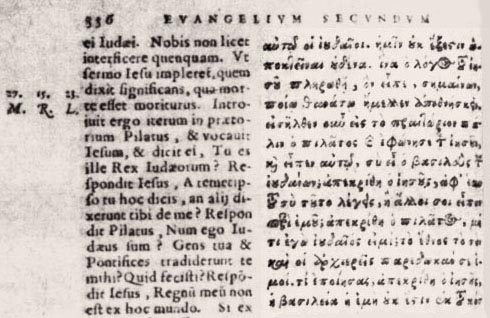 |
This printed Greek text and subsequent
editions became the basis for translating the New Testament in the various
European languages for the next two hundred years. This to the slim extent
that those translations consulted an original language text, rather than
depending exclusively on the Vulgate as the foundational text for translation.
Second,
the emergence of biblical
archaeology in the eighteen hundreds gradually began uncovering more
and more manuscript fragments and occasionally virtually complete texts
of the New Testament. These copies went further back in time than the few
manuscripts that Erasmus had used to produce his printed Greek text. As
more and more texts of the Bible were discovered, biblical scholars began
noticing increasing variations of wording from the text of the Textus Receptus.
The discovery of Codex
Alexandrinus in the early 1800s became a catalyst for much of this,
since it was a fifth century copy of virtually the entire text of the New
Testament. The manuscripts used in the Textus Receptus only went back to
the middle ages. So here was a Greek text reaching back centuries farther
than anything connected to the Textus Receptus. And, most importantly,
it contained numerous differences in wording from that of the Textus Receptus.
Increasingly, biblical scholars became alarmed about the trust worthiness
of the Greek text that lay underneath the translations in the Textus Receptus.
Over the past 150 years, we have moved
from having access to barely a dozen very late and very inferior Greek
manuscripts of the New Testament to over 5,300 manuscripts. Many of these
manuscripts move to within four centuries of the original writings of the
documents of the New Testaments, and, in a few instances, manuscript fragments
move to with a century of the compositional date. Many of these manuscripts
are very high quality, as well as being dated very early. Add to this,
the discovery of ancient
translations in Latin, Syriac, Coptic, Armenian, Ethiopic, Georgian
and other languages. This pushes the available texts of the New Testament
in translation form back to within a few centuries of the original writing
dates. Complementing this still growing mountain of evidence are the lectionaries
written in Greek that quote large portions of the New Testament. Additionally
are the Church
Fathers, especially those who wrote in Greek, who also quote from the
Greek text of the New Testament being used in their writing.
Unlike the challenge with the ancient
Hebrew and Greek texts of the Old Testament where very few manuscripts
go back to within a few centuries of the original date of writing, scholars
in New Testament Textual Criticism face the huge challenge of sifting through
literally thousands and thousands of ancient manuscripts as they attempt
to get at the most likely reading of the original writing of the New Testament
documents. A systematic method of evaluating all this evidence becomes
essential.
3.2.2
A glance at how the experts do it
The essence of this procedure is first
to compare external evidence, that is, available manuscripts for the scripture
text. Then internal evidence, i.e., patterns of scribal writing showing
up inside the Greek text, is analyzed. When a variety of alternative "readings"
of a word, phrase etc. shows up in a scripture passage, then both the external
and internal evidence are compared in order to draw a conclusion regarding
"the most likely original reading" of the Greek text.
The possible readings are evaluated
externally by (1) how early the manuscript
support is for each reading, by (2) widely geographical regions the readings
existed in, and by (3) which text family or tradition they belong to. The
earlier a certain reading is, the more widely distributed it is geographically,
and the more text types it can be found in, the stronger is the evidence
supporting a certain reading of the text. Internally,
two areas of evaluation are use: (1) what the scribes probably did when
copying the New Testament (Transcriptional Probabilities), and (2) what
the author most likely wrote himself (Intrinsic Probabilities).
For a more detailed explanation see
my my "EVALUATION OF VARIOUS READINGS ACCORDING TO THE THEORY OF RATIONAL
ECLECTICISM" in Supplementary
Helps in Greek 202
at Cranfordville.com in the Academic Section (in pdf
file format). It is summarized by the following chart:
EVALUATION OF EXTERNAL EVIDENCE
1. Date.
2. Geographical Distribution.
3. Textual Relationships.
Summary of the External Evidence |
EVALUATION OF THE INTERNAL EVIDENCE
1. Transcriptional Probabilities,
i.e. what scribes likely did when copying the N.T.
(1)
Shorter/Longer Reading.
(2)
Reading Different from Parallel.
(3)
More Difficult Reading.
(4)
Reading Which Best Explains Origin of Other(s).
2. Intrinsic Probabilities,
i.e. what the author himself likely wrote.
Summary of Internal Evidence |
In the UBS 4th revised edition the critical
apparatus applies this procedure and then rates the reading used for the
text with a grading system. An "A" represents the highest level of
confidence and a "D" the lowest level of confidence. The descending scale
of certainty reflects a balancing of weight among the possible readings
so that one cannot be as certain about which one of the readings was the
original. The alternative readings, called variant readings, have less
evidence supporting them.
Some representative types of ancient
copies of the Greek New Testament are:
 |

|
| This manuscript is Papyrus
66 that dates from about 200 AD. The all caps Greek writing was done
on papyrus, the most common writing material of
that time. P66 contains most of the Gospel of John. |
This manuscript is Uncial Sinaiticus
(01) that dates during the fourth century AD. It was written on parchment,
the material that became common after Christianity became the official
religion of the Roman Empire. It contains virtually all of the New Testament |
 |
| This is a minusucle manuscript and
illustrates a later "script" style of writing that developed toward the
end of the ancient period. It became the dominant way of writing Greek
and thus most all the later manuscripts of the Greek New Testament are
written in this style of writing. Previously Greek had been "printed" using
only capital letters, as can be seen from the two above manuscripts written
on papyrus and parchment. |
3.2.3
The
results of their work: printed Greek and Hebrew texts
For students of the Greek New Testament,
the two most commonly used printed Greek texts of the New Testament are
The United Bible Societies' Greek New Testament fourth revised edition
and the Nestle-Aland Novum Testamentum Graece 27th edition. Both provide
a "critical apparatus" at the bottom of each page that lists the major
manuscripts supporting the possible alternative readings. The Logos
Bible Software site has a helpful explanation of these features for
both the Greek New Testament and the Hebrew Old Testament. For the instructions
and examples that I use with the Greek 202 students when they begin practicing
the procedure see my "EVALUATION OF VARIOUS READINGS ACCORDING TO THE THEORY
OF RATIONAL ECLECTICISM" in Supplementary
Helps in Greek 202
at Cranfordville.com in the Academic Section (in pdf
file format). For another very helpful summation of the history of
Text Criticism, see Ronald J. Gordan's Comparing
Translations.
From these two illustrations below of
the UBS text and then the Nestle-Aland Greek texts you can see something
of what they look like. I have indicated by label and highlighting the
Greek text, then the Critical Apparatus and also the cross references to
other verses in each one.
For the really "eager beavers" in the
group Prof. Sied has created an "exercise in textual criticism" using the
English language set up to simulate what one would find in the Greek New
Testament. It's fun to go through, and also provides a "hands on" feel
for what this procedure is all about. Click on the  icon in Sied's Interpreting
Ancient Manuscripts web site. Also, professor Elliott has a very helpful
list of examples
that one can work through in order to gain a feel for doing this kind of
work.
icon in Sied's Interpreting
Ancient Manuscripts web site. Also, professor Elliott has a very helpful
list of examples
that one can work through in order to gain a feel for doing this kind of
work.
3.2.4
How
does this work impact your study of the Bible?
At least two areas of consequence will
be seen for the reader of the English Bible. First,
Bible translation means that the translators have to have a Greek New Testament
in hand as the starting point for translation. You can't "translate" without
a source text to translate. In today's world of Bible translation,
this means the use of the most reliable Greek text possible, since the
goal is to translate into English the most likely wording of the original
text of the New Testament documents. Textual criticism is the procedure
for establishing that Greek text as far as is humanly possible.
The consequence of this will also mean
that sometimes when different English translations have significantly different
wording in passages, they are working from different Greek texts of the
New Testament. This will particularly be true when comparing the King James
Version to an English translation produced in the second half of the twentieth
century onward. Also the New King James Version and the 1979 Revised King
James Version will use a sometimes radically different Greek text than
the other English translations.
Another impact
will be seen in the more recent English translations in their footnote
system. For example, the New
Revised Standard Version has a footnote in the middle of 1:18. The
printed translation reads: "No one has ever seen
God. It is God the only Son,e/F5
who is close to the Father's heart, who has made him known." Footnote
e/F5
then reads: "Other ancient authorities read It
is an only Son, God, or It
is the only Son." What
this difference in translation means is that the manuscripts of this verse
in John differ on their wording of the text. The weight of evidence is
not decisive one direction or the other. The translators of the NRSV concluded
on one reading of the Greek text and then gave their English translation
based on that understanding. But they are being honest with us readers
by inserting a footnote to suggest how the English translation would differ
if the one of the two other possible readings of the Greek text were adopted.
3.3
The
importance of the Latin Vulgate: What
Bible have Christians mostly used over the centuries?
One of the first languages that the
New Testament documents were translated into was Latin.
This language was spoken first on the Italian peninsula and then with the
establishment of the Roman Empire just before the beginning of the Christian
era it became the official language of the Roman government all over the
Mediterranean world.
3.3.1
Establishing the Vulgate
 ---There
were many efforts to translate the Greek original documents into “old Latin”
but from
the
available Latin translations it is clear that the majority of these
were
of very poor quality. The situation deteriorated to the point that
“in
382 that Pope Damascus (366-384) called upon Jerome (Sophronius Eusebius
Hieronymus) to remedy the situation. Jerome
was the greatest scholar of his generation, and the Pope asked him to make
an official Latin version -- both to remedy the poor quality of the existing
translations and to give one standard reference for future copies. Damasus
also called upon Jerome to use the best possible Greek texts -- even while
giving him the contradictory command to stay as close to the existing versions
as possible” (“Vulgate,” Encyclopedia
of Textual Criticism).
---There
were many efforts to translate the Greek original documents into “old Latin”
but from
the
available Latin translations it is clear that the majority of these
were
of very poor quality. The situation deteriorated to the point that
“in
382 that Pope Damascus (366-384) called upon Jerome (Sophronius Eusebius
Hieronymus) to remedy the situation. Jerome
was the greatest scholar of his generation, and the Pope asked him to make
an official Latin version -- both to remedy the poor quality of the existing
translations and to give one standard reference for future copies. Damasus
also called upon Jerome to use the best possible Greek texts -- even while
giving him the contradictory command to stay as close to the existing versions
as possible” (“Vulgate,” Encyclopedia
of Textual Criticism).
It would take him until well into the
400s to complete this project since he did a substantial amount of comparing
available Greek and Hebrew manuscripts of the Old Testament and Greek manuscripts
of the New Testament. The mandate was to use the best manuscripts but to
stay close to the existing Latin translations. This necessitated careful
translation work in trying to strike a balance. Jerome faced what modern
Bible translators have often faced. In the beginning, his work was soundly
criticized because it departed in places from accepted wording found in
both some popular old Latin versions and, even more, from the very popular
Greek Septuagint. But Jerome based his deviations on solid analysis of
available manuscripts in both Latin and Greek. Gradually, those criticisms
faded.
The copying of Jerome's Vulgate took
place from the 400s to the 1500s and resulted in lines or families of texts
in the many generations of copies. Unfortunately, the quality of the copying
process tended to become increasingly inferior and thus the quality of
the Vulgate text deteriorated substantially over time. Numerous variations
of readings of the Vulgate surfaced, so that the situation by the 1500s
became pretty much the same as that which had prompted the creation of
the Vulgate in the late 300s with the Old Latin texts of the Bible.
The Encyclopedia
of Textual Criticism offers a summary of the various "families" of
Vulgate texts that developed:
With that firmly in mind, let us turn to the various types of Vulgate text
which evolved over the centuries. As with the Greek manuscripts, the various
parts of Christendom developed their own "local" text.
The best "local" text is considered to be the Italian
type, as represented e.g. by am and ful. This
text also endured for a long time in England (indeed, Wordsworth and White
call this group "Northumbrian"). It has formed the basis for most recent
Vulgate revisions.
Believed to be as old as the Italian, but less reputable, is the Spanish
text-type, represented by cav and tol. Jerome
himself is said to have supervised the work of the first Spanish scribes
to copy the Vulgate (398), but by the time of our earliest manuscripts
the type had developed many peculiarities (some of them perhaps under the
influence of the Priscillians, who for instance produced the "three heavenly
witnesses" text of 1 John 5:7-8).
The Irish text
is marked by beautiful manuscripts (the Book of Kells and the Lichfield
Gospels, both beautiful illuminated manuscripts, are of this type, and
even unilliminated manuscripts such as the Rushworth Gospels and the Book
of Armagh are beautiful examples of calligraphy). Sadly, these manuscripts
are often marred by conflations and inversions of word order. Some of the
manuscripts are thought to have been corrected from the Greek -- though
the number of Greek scholars in the Celtic church must have been few indeed.
Lemuel J. Hopkins-James, editor of The Celtic Gospels (essentially a critical
edition of codex Lichfeldensis) offers another theory: that this sort of
text (which he calls "Celtic" rather than Irish) is descended not from
a pure Vulgate manuscript but from an Old Latin source corrected against
a Vulgate. (It should be noted, however, that Hopkins-James uses statistical
comparisons to support this result, and the best word I can think of for
his method is "ludicrous.")
The "French" text
has been described as a mixture of Spanish and Irish readings. The text
of Gaul (France) has been called "unquestionably"
the worst of the local texts.
The wide variety of Vulgate readings in Charlemagne's time caused that
monarch to order Alcuin to attempt to create a uniform version (the exact
date is unknown, but he was working on it in 800). Unfortunately, Alcuin
had no critical sense, and the result was not a particularly good text.
Still, his revision was issued in the form of many beautiful codices.
Another scholar who tried to improve the Vulgate was Theodulf, who also
undertook his task near the beginning of the ninth century. Some have accused
Theodulf of contaminating the French Vulgate with Spanish readings, but
it appears that Theodulf really was a better scholar than Alcuin, and produced
a better edition than Alcuin's which also included information about the
sources of variant readings. Unfortunately, such a revision is hard to
copy, and it seems to have degraded and disappeared quickly (though manuscripts
such as theo, which are effectively contemporary with the edition, preserve
it fairly well).
Other revisions were undertaken in the following centuries, but they really
accomplished little; even if someone took notice of the revisors' efforts,
the results were not particularly good. When it finally came time to produce
an official Vulgate (which the Council of Trent declared an urgent need),
the number of texts in circulation was high, but few were of any quality.
The result was that the "official" Vulgate editions (the Sixtine
of 1590, and its replacement the Clementine
of 1592) were very bad. Although good manuscripts
such as Amiatinus were consulted, they made little impression on the editors.
The Clementine edition shows an amazing ability to combine all the faults
of the earlier texts. Unfortunately, it was to be nearly three centuries
before John Wordsworth undertook a truly critical edition of the Vulgate,
and another century after that before the Catholic Church finally accepted
the need for revised texts.
Despite all that has been said, the Vulgate remains an important version
for criticism, and both its "true" text and the variants can help us understand
the history of the text. We need merely keep in mind the personalities
of our witnesses. The table below is intended to help with that task as
much as possible.
At the Council
of Trent in 1545, the Roman Catholic Church declared the Vulgate to
be the official Bible of the church. This was in reaction to Protestants
placing increasing stress on the original language texts of the Bible.
In 1590 the Catholic Church published the Sixtine Vulgate, but upon realizing
the sorry manuscript basis it quickly released a revision in 1592 known
as Clementine
Vulgate. Unfortunately, the quality of the manuscript basis for this
revision wasn't very much better than for the Sixtine Vulgate. John Wadsworth,
Bishop of Salisbury (1885-1911), and H.J. White, at the end of the 1800s
produced a revision in 1889. This edition had better manuscript evaluation
underneath it. The Nova Vulgata released initially in 1979 for the entire
Bible is the current official version of the Vulgate for the Roman
Catholic Church. This current edition is the product of a commission appointed
in 1965 by Pope John Paul VI at the end of the Second Vatican Council.
This edition is based on careful analysis of the many manuscripts housed
in Rome at the Vatican library. Below is a copy of the Nova Vulgata translation
of John 1:1-18. I've included in the right hand column the New Revised
Standard Version translation of the same scripture passage in contemporary
English.
| The
Latin Vulgate |
NRSV |
1 in principio erat Verbum et Verbum erat apud Deum et Deus erat Verbum
2 hoc erat in principio apud Deum 3 omnia per ipsum facta sunt et sine
ipso factum est nihil quod factum est 4 in ipso vita erat et vita erat
lux hominum 5 et lux in tenebris lucet et tenebrae eam non conprehenderunt
6 fuit homo missus a Deo cui nomen erat Iohannes 7 hic venit in testimonium
ut testimonium perhiberet de lumine ut omnes crederent per illum 8 non
erat ille lux sed ut testimonium perhiberet de lumine 9 erat lux vera quae
inluminat omnem hominem venientem in mundum 10 in mundo erat et mundus
per ipsum factus est et mundus eum non cognovit 11 in propria venit et
sui eum non receperunt 12 quotquot autem receperunt eum dedit eis potestatem
filios Dei fieri his qui credunt in nomine eius 13 qui non ex sanguinibus
neque ex voluntate carnis neque ex voluntate viri sed ex Deo nati sunt
14 et Verbum caro factum est et habitavit in nobis et vidimus gloriam eius
gloriam quasi unigeniti a Patre plenum gratiae et veritatis 15 Iohannes
testimonium perhibet de ipso et clamat dicens hic erat quem dixi vobis
qui post me venturus est ante me factus est quia prior me erat 16 et de
plenitudine eius nos omnes accepimus et gratiam pro gratia 17 quia lex
per Mosen data est gratia et veritas per Iesum Christum facta est 18 Deum
nemo vidit umquam unigenitus Filius qui est in sinu Patris ipse enarravit |
1 In the beginning was the Word, and the Word was with God, and the Word
was God. 2 He was in the beginning with God. 3 All things came into being
through him, and without him not one thing came into being. What has come
into being 4 in him was life, and the life was the light of all people.
5 The light shines in the darkness, and the darkness did not overcome it.
6 There was a man sent from God, whose name was John. 7 He came as a witness
to testify to the light, so that all might believe through him. 8 He himself
was not the light, but he came to testify to the light. 9 The true light,
which enlightens everyone, was coming into the world. 10 He was in the
world, and the world came into being through him; yet the world did not
know him. 11 He came to what was his own, and his own people did not accept
him. 12 But to all who received him, who believed in his name, he gave
power to become children of God, 13 who were born, not of blood or of the
will of the flesh or of the will of man, but of God.
14 And the Word became flesh and lived among us, and we have seen his glory,
the glory as of a father's only son, full of grace and truth. 15 (John
testified to him and cried out, "This was he of whom I said, "He who comes
after me ranks ahead of me because he was before me.' ") 16 From his fullness
we have all received, grace upon grace. 17 The law indeed was given through
Moses; grace and truth came through Jesus Christ. 18 No one has ever seen
God. It is God the only Son, who is close to the Father's heart, who has
made him known. |
3.3.2
The challenges to the Vulgate in the Protestant
Reformation
 ---When
Martin Luther began his "protests" against the abuses of the leadership
of the Roman Catholic Church in the early 1500s, one of his driving motives
was the life changing experience he had undergone through intensive study
of the Bible, and in particular, the letters of Romans and Galatians.
---When
Martin Luther began his "protests" against the abuses of the leadership
of the Roman Catholic Church in the early 1500s, one of his driving motives
was the life changing experience he had undergone through intensive study
of the Bible, and in particular, the letters of Romans and Galatians.
From
1510 to 1520, Luther lectured on the Psalms, the books of Hebrews, Romans
and Galatians. As he studied these portions of the Bible, he came to understand
terms such as penance and righteousness in new ways. He began to teach
that salvation is a gift of God's grace through Christ received by faith
alone.[23]
The first and chief article is this, Luther wrote, "Jesus Christ, our God
and Lord, died for our sins and was raised again for our justification
... herefore, it is clear and certain that this faith alone justifies us...Nothing
of this article can be yielded or surrendered, even though heaven and earth
and everything else falls."[24]
("Martin Luther," Wikipedia
Encyclopedia)
As a university lecturer on biblical materials,
he found himself immersed in the study of the Bible. Also, haunted by his
personal uncertainty about his own salvation, this study -- at the advice
of his superior, Johann von Staupitz -- focused on the theme of Christ.
This study and the teaching especially of Romans and Galatians brought
him to a conversion experience. Increasingly, Luther realized the church's
teachings and practices were contradicted by scripture. He began lecturing
about
this and came increasingly into trouble with the Vatican. When Luther finally
broke completely with the Catholic Church in the 1520s after being excommunicated,
one of the ways Luther determined to use to spread his teachings was through
translating the Bible into the everyday German language of that day. The
complete Luther Bibel was released in 1534.
But his translation, although helping
to greatly diminish the use of the Vulgate in the emerging Lutheran churches
in central and northern Europe, was none the less dependent on the Vulgate.
For example, Luther had depended on the Greek Textus
Receptus that had come from Erasmus, but he also was careful to not
depart too far from the Vulgate as well. He consulted the Vulgate heavily
in doing his German translation. This "love/hate" relationship with the
Vulgate by Protestants would continue well into the 1800s. Long after the
Vulgate -- in public eyes -- had become the Bible of Roman Catholics and
Protestants had their own Bible in their particular native language, the
influence of the Vulgate would continue to be felt in these translations.
| Die Luther Bibel |
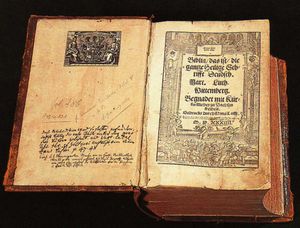 |
Over time he developed the idea of the
central role of scripture as the sole foundation for determining what Christians
should believe and how they should live. Called in the Latin
sola
scriptura, this principle gradually became adopted by all the Protestant
reformers, and has served as a central stance among Protestants until this
day. Thus Luther's renewed emphasis upon the Bible both through translation
and about its importance presented a growing challenge to the Latin Vulgate.
The translation of the scriptures into the "vernacular"
language of that time and region shifted the emphasis to the people having
a Bible in their own language so that they could read and understand it
for themselves. Increasingly, the Vulgate was associated with the Roman
Catholic Church. Protestants in general did what ever they could to distance
themselves from the Roman Church. Bible translation helped accomplish that.
The other
early reformers such as John
Calvin--- and Huldrych Zwingli---
and Huldrych Zwingli---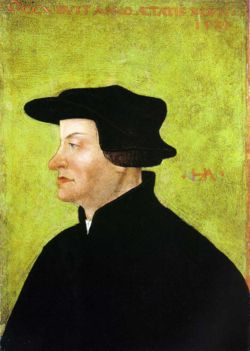 followed Luther's example with a strong emphasis upon the scriptures and
interpreting them to the masses of the people. Consequently, the Protestant
Reformation began the path to the identification of the Vulgate solely
with the Roman Catholic Church. For Protestantism the study of the scriptures
increasingly in the original biblical languages and then translating them
into the vernacular language has become one of the distinguishing marks
of this movement.
followed Luther's example with a strong emphasis upon the scriptures and
interpreting them to the masses of the people. Consequently, the Protestant
Reformation began the path to the identification of the Vulgate solely
with the Roman Catholic Church. For Protestantism the study of the scriptures
increasingly in the original biblical languages and then translating them
into the vernacular language has become one of the distinguishing marks
of this movement.
3.3.3
How Gutenberg changed the Bible
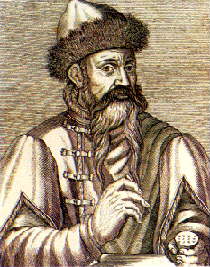 ---Another
factor helping to place greater emphasis upon the Bible and its importance
for Christians generally was the invention of the printing press by Johannes
Gutenberg in 1447. He produced the first printed copy of the
Vulgate in 1455, and subsequently it is known as the Gutenberg
Bible.
---Another
factor helping to place greater emphasis upon the Bible and its importance
for Christians generally was the invention of the printing press by Johannes
Gutenberg in 1447. He produced the first printed copy of the
Vulgate in 1455, and subsequently it is known as the Gutenberg
Bible.
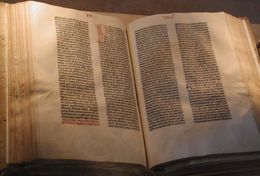 -----
-----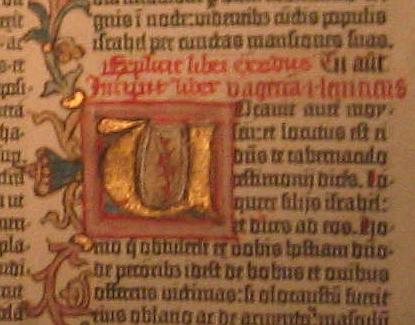 ----Of
the appx. 180 copies first printed, several still exist in libraries scattered
around the world. The mass production of the Bible for a fraction of the
cost of the hand copied scriptures forever changed not only western culture
but the use of the Christian Bible as well. Books could now be produced
in large quantities and at very reasonable prices for that era. Consequently,
the distribution of the Bible expanded dramatically all across Europe.
When Luther released his translation of the Bible in German half a century
later, he took advantage of the printing press and mass produced it for
rapid distribution all across the German speaking sections of Europe. Thus,
before the Vatican could have time to stamp out Luther's movement, it spread
dramatically through the use of the printing press. Subsequently when other
translations of the Bible would be produced as time passed, the printing
press made it possible to print large quantities for wide distribution.
Increasingly, this made it possible for individuals to own their own copy
of the Bible. Previously, a single copy of the Bible could be found at
most of the churches. But only rarely would individuals own their own copy.
The printing press forever changed that. The Protestant emphasis on the
central role of scripture for Christian belief and practice was enhanced
by the availability of the scriptures for personal study.
----Of
the appx. 180 copies first printed, several still exist in libraries scattered
around the world. The mass production of the Bible for a fraction of the
cost of the hand copied scriptures forever changed not only western culture
but the use of the Christian Bible as well. Books could now be produced
in large quantities and at very reasonable prices for that era. Consequently,
the distribution of the Bible expanded dramatically all across Europe.
When Luther released his translation of the Bible in German half a century
later, he took advantage of the printing press and mass produced it for
rapid distribution all across the German speaking sections of Europe. Thus,
before the Vatican could have time to stamp out Luther's movement, it spread
dramatically through the use of the printing press. Subsequently when other
translations of the Bible would be produced as time passed, the printing
press made it possible to print large quantities for wide distribution.
Increasingly, this made it possible for individuals to own their own copy
of the Bible. Previously, a single copy of the Bible could be found at
most of the churches. But only rarely would individuals own their own copy.
The printing press forever changed that. The Protestant emphasis on the
central role of scripture for Christian belief and practice was enhanced
by the availability of the scriptures for personal study.
Bibliography
How do I learn
more about this?
Online:
Ancient
Methods of Writing and Copying
The Encyclopedia
of New Testament Textual Criticism, "Ancient Writing Materials": http://www.skypoint.com/~waltzmn/WritingMaterials.html
"Ancient Writing":
http://dreamwater.org/bccox/writing.html
The University
of Michigan Papyrus Collection, "Learning About Papyrology : Ancient
Writing Materials":
http://www.lib.umich.edu/pap/k12/materials/materials.html
The Encyclopedia
of New Testament Textual Criticism, "Books and Book Making" : http://www.skypoint.com/~waltzmn/BookMaking.html
Google search
of books in print treating ancient writing:
http://books.google.com/books?q=Ancient+Methods+of+Writing&ots=wjczpu5HGM&sa=X&oi=print&ct=title
Textual Criticism:
James R. Adair,
Jr. "Old and New in Textual Criticism: Similarities, Differences, and Prospects
for Cooperation":
http://rosetta.reltech.org/TC/vol01/Adair1996.html
Lengthy
article written for the SBL seminar presentation by a former student of
mine comparing similarities and differences between OT and NT Textual Criticism.
Wikipedia, "Textual
Criticism": http://en.wikipedia.org/wiki/Textual_Criticism
General
article on the practice of copying ancient manuscripts of all kinds of
literature, including the OT, the NT, and classical writings.
Tony Seid, Interpreting Ancient Manuscripts:
http://www.earlham.edu/~seidti/iam/interp_mss.html
Very
helpful web site on Textual Criticism with numerous graphics illustrating
manuscripts and procedures.
New Testament
Textual Criticism:
New Testament
Gateway, "Textual Criticism": http://ntgateway.com/resource/textcrit.htm
The Encyclopedia
of New Testament Textual Criticism: http://www.skypoint.com/~waltzmn/
Wikipedia, "Uncial": http://en.wikipedia.org/wiki/Uncials
Lorin Cranford, "Learning Textual Criticism,"
Cranfordville.com: http://cranfordville.com/g202TxtCritStdy.html#Wk1
Section
of fourth semester Greek studies, Greek 202, designed to introduce the
practice of textual criticism to students of biblical koine Greek.
Old Testament
Textual Criticism:
Old Testament
Textual Criticism: http://www.skypoint.com/~waltzmn/OTCrit.html
Hebrew Old Testament,
"Textual Criticism": http://www.bible-researcher.com/links08.html
August Meek, "The
Old Testament," Catholic Encyclopedia: http://www.newadvent.org/cathen/14526a.htm
Article
traces the manuscript transmission of the text of the Old Testament.
Bruce K. Waltke,
"Aims of OT Textual Criticism," Westminster Theological Journal
51.1 (Spring 1989): 93-108:
http://www.biblicalstudies.org.uk/article_textual_waltke.html
Article
discusses what OT Textual Criticism hopes to accomplish by comparing various
objectives over the modern era.
The Latin Vulgate
The Encyclopedia
of New Testament Textual Criticism, "The Vulgate": http://www.skypoint.com/~waltzmn/Versions.html#Vulgate
The Catholic
Encyclopedia, "Revision of the Vulgate": http://www.newadvent.org/cathen/15515b.htm
Wikipedia, "Vulgate": http://en.wikipedia.org/wiki/Vulgate
“Latin,” Wikipedia Encyclopedia: http://en.wikipedia.org/wiki/Latin
“Bible Versions, Ancient,” The New Schaff-Herzog
Encyclopedia of Religious Knowledge:
http://www.bible-researcher.com/schaff02.html
Martin Luther
"Martin Luther:
The Reluctant Revolutionary," Public Broadcasting Service: http://www.pbs.org/empires/martinluther/
"Martin Luther," Wikipedia: http://en.wikipedia.org/wiki/Martin_luther
Johannes Gutenberg
Wikipedia, "Johannes Gutenberg": http://en.wikipedia.org/wiki/Johannes_Gutenberg
Wikipedia, "Gutenberg Bible": http://en.wikipedia.org/wiki/Gutenberg_Bible
"Gutenberg: Man of the Millennium":
http://www.mainz.de/gutenberg/index.htm
Catholic Encylopedia, "Johann Gutenberg"
: http://www.newadvent.org/cathen/07090a.htm
Check the appropriate Bibliography
section in Cranfordville.com
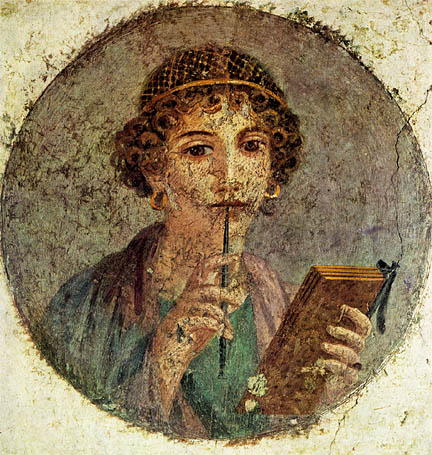
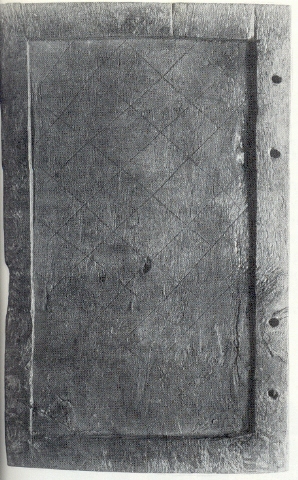

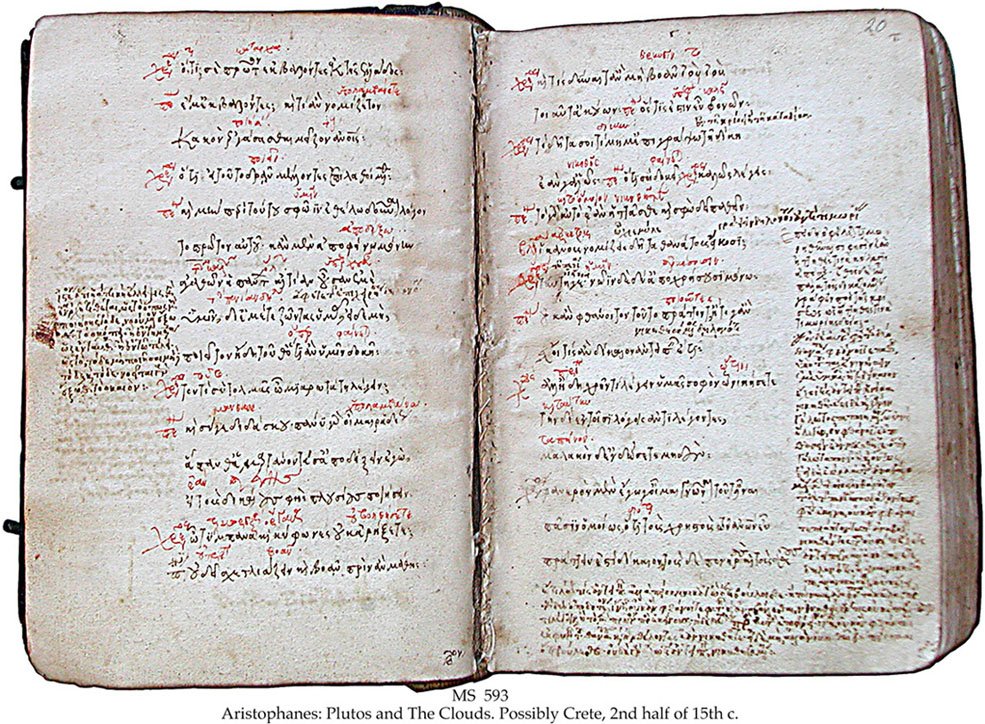







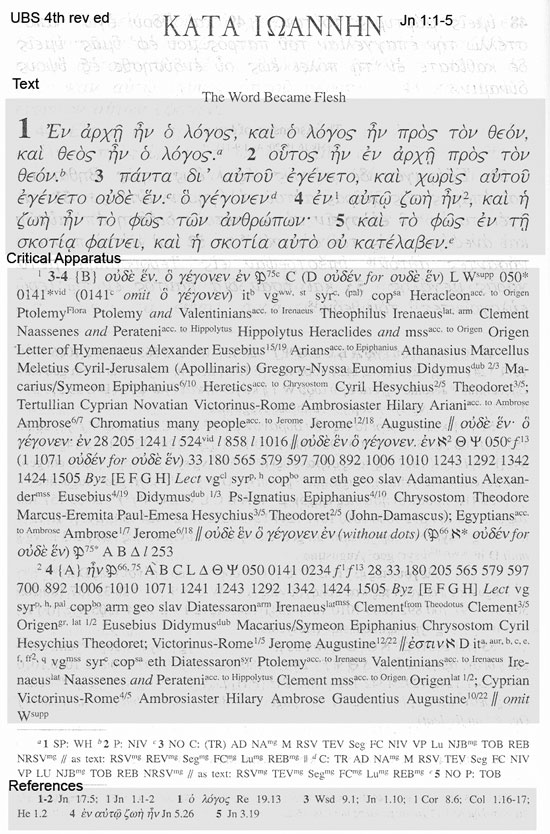

 ---There
were many efforts to translate the Greek original documents into “old Latin”
but from
---There
were many efforts to translate the Greek original documents into “old Latin”
but from
 ---When
Martin Luther began his "protests" against the abuses of the leadership
of the Roman Catholic Church in the early 1500s, one of his driving motives
was the life changing experience he had undergone through intensive study
of the Bible, and in particular, the letters of Romans and Galatians.
---When
Martin Luther began his "protests" against the abuses of the leadership
of the Roman Catholic Church in the early 1500s, one of his driving motives
was the life changing experience he had undergone through intensive study
of the Bible, and in particular, the letters of Romans and Galatians.

 and
and  followed Luther's example with a strong emphasis upon the scriptures and
interpreting them to the masses of the people. Consequently, the
followed Luther's example with a strong emphasis upon the scriptures and
interpreting them to the masses of the people. Consequently, the  ---Another
factor helping to place greater emphasis upon the Bible and its importance
for Christians generally was the invention of the printing press by
---Another
factor helping to place greater emphasis upon the Bible and its importance
for Christians generally was the invention of the printing press by  -----
----- ----Of
the appx. 180 copies first printed, several still exist in libraries scattered
around the world. The mass production of the Bible for a fraction of the
cost of the hand copied scriptures forever changed not only western culture
but the use of the Christian Bible as well. Books could now be produced
in large quantities and at very reasonable prices for that era. Consequently,
the distribution of the Bible expanded dramatically all across Europe.
When Luther released his translation of the Bible in German half a century
later, he took advantage of the printing press and mass produced it for
rapid distribution all across the German speaking sections of Europe. Thus,
before the Vatican could have time to stamp out Luther's movement, it spread
dramatically through the use of the printing press. Subsequently when other
translations of the Bible would be produced as time passed, the printing
press made it possible to print large quantities for wide distribution.
Increasingly, this made it possible for individuals to own their own copy
of the Bible. Previously, a single copy of the Bible could be found at
most of the churches. But only rarely would individuals own their own copy.
The printing press forever changed that. The Protestant emphasis on the
central role of scripture for Christian belief and practice was enhanced
by the availability of the scriptures for personal study.
----Of
the appx. 180 copies first printed, several still exist in libraries scattered
around the world. The mass production of the Bible for a fraction of the
cost of the hand copied scriptures forever changed not only western culture
but the use of the Christian Bible as well. Books could now be produced
in large quantities and at very reasonable prices for that era. Consequently,
the distribution of the Bible expanded dramatically all across Europe.
When Luther released his translation of the Bible in German half a century
later, he took advantage of the printing press and mass produced it for
rapid distribution all across the German speaking sections of Europe. Thus,
before the Vatican could have time to stamp out Luther's movement, it spread
dramatically through the use of the printing press. Subsequently when other
translations of the Bible would be produced as time passed, the printing
press made it possible to print large quantities for wide distribution.
Increasingly, this made it possible for individuals to own their own copy
of the Bible. Previously, a single copy of the Bible could be found at
most of the churches. But only rarely would individuals own their own copy.
The printing press forever changed that. The Protestant emphasis on the
central role of scripture for Christian belief and practice was enhanced
by the availability of the scriptures for personal study.